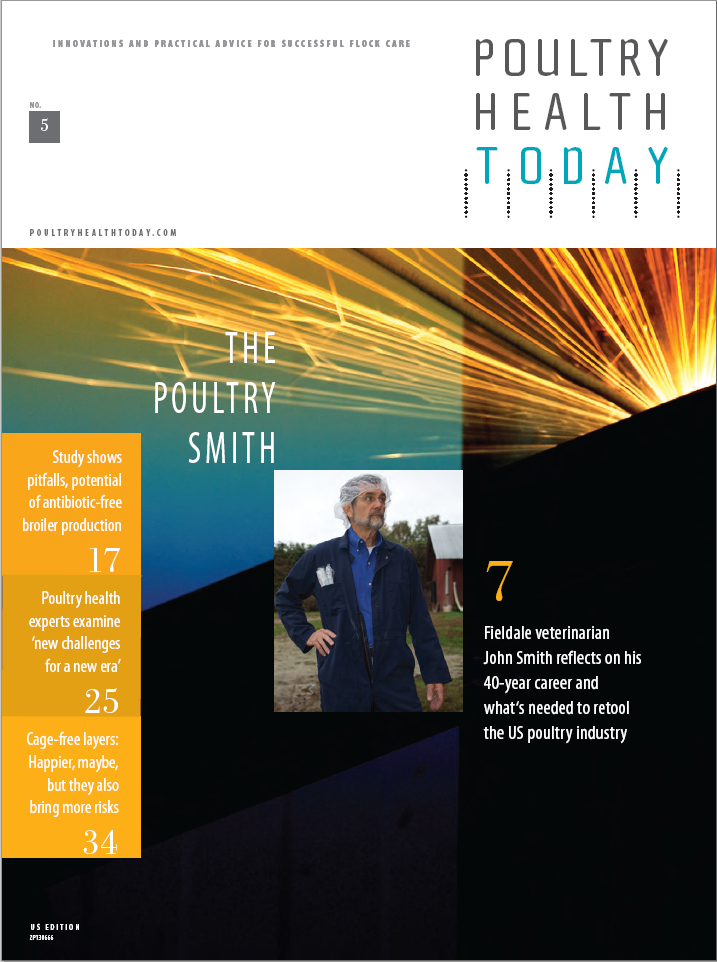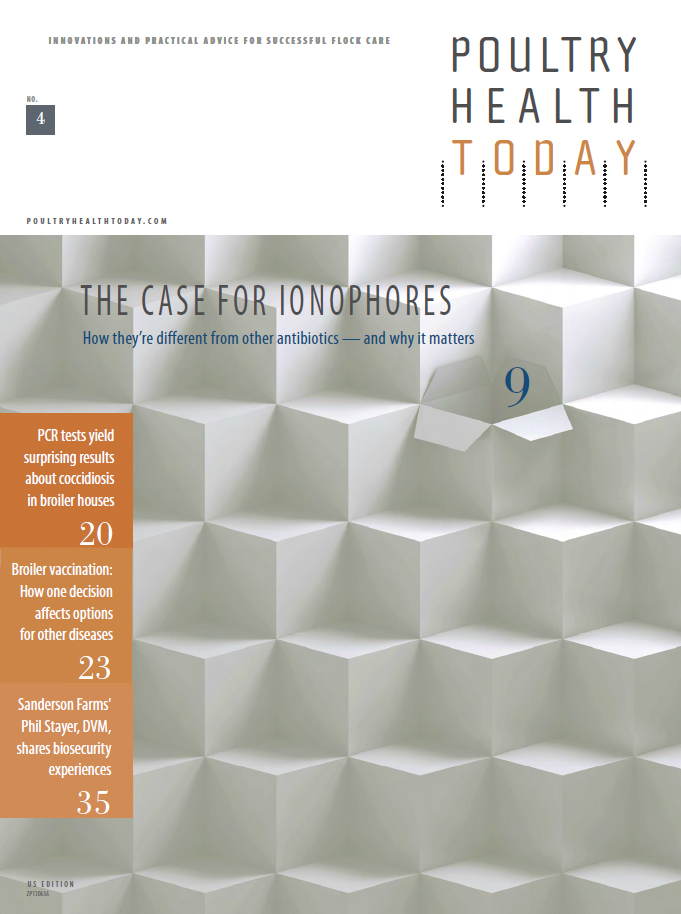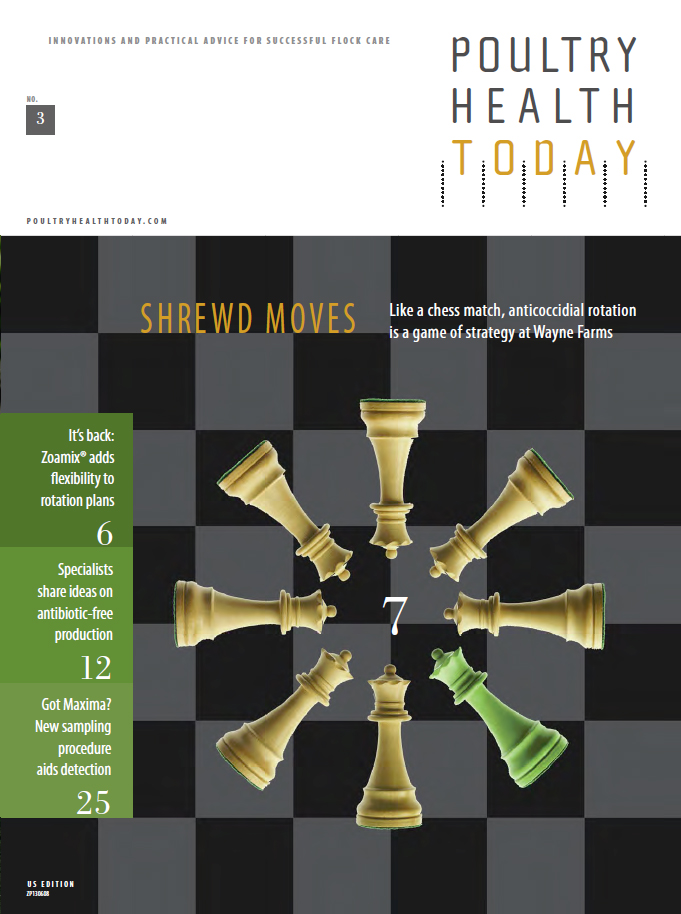

The case for ionophores: How they’re different from other antibiotics - and why it matters

Ionophores are unlike other classes of antibiotics and are not considered important to human health by leading public health and regulatory agencies.
Earlier this year, when McDonald’s USA announced it would require chicken suppliers to phase out antibiotics, the fast-food giant made one notable exception.1
It gave a pass to a class of antibiotics called ionophores — medications like monensin, salinomycin, lasalocid, to name a few — because they’re among the shrinking list of in-feed antibiotics not considered medically important to human medicine by the World Health Organization (WHO).
The fast-food chain went on to say it recognizes that judicious use of drugs such as ionophores are an integral part of an overall animal health and welfare program.
“The oocysts thrive in warm, humid environments, although coccidiosis is a threat to poultry farms year-round and in arid climates as well,” he explains. “Eradicating them from poultry farms has proved to be virtually impossible. No matter where you go throughout the world, coccidiosis is considered one of the top diseases of poultry.”
For the most part, food-safety advocates, veterinarians and poultry industry groups reacted favorably to McDonald’s announcement, calling it a sensible compromise — one that addressed consumers’ growing concerns about antibiotics while allowing the continued use of certain medications for maintaining good flock health and welfare.
In this special report, Poultry Health Today looks at the science behind ionophores and why they’re viewed differently from other antibiotics.
Understanding ionophores
The first thing poultry decision-makers need to know is that ionophores are not used in human medicine.
Although they are classified as antibiotics, they are not even used therapeutically in chickens to treat bacterial infections. They are used as antiparasitics to manage coccidia, a family of protozoan parasites that cause coccidiosis — widely considered the most costly intestinal disease of poultry.
Coccidia are persistent parasites found worldwide on all types of poultry farms, whether they are small backyard hobby flocks or large commercial operations. Just one microscopic coccidial oocyst, or egg, can produce over 500,000 progeny in just 4 to 7 days.
If not kept in check, coccidia cause extensive gut damage, animal suffering and, in severe cases, death that leads to huge economic losses for poultry farmers.
Coccidiosis also predisposes chickens to other problems, such as clostridial bacterial infections, which can lead to another serious gut disease known as necrotic enteritis.
Guilt by association
Poultry veterinarians and producers consider ionophores essential for maintaining the health and welfare of commercial flocks, while working to meet the ever-growing world demand for affordable poultry.
But if ionophores in poultry are used only to control parasites, why are they even considered antibiotics?
Like many other antibiotics, ionophores are derived from naturally occurring bacteria.2 Monensin, for instance, is derived from Streptomyces cinnamonensis; salinomycin is derived from Streptomyces albus. They are also active against many Gram-positive bacteria.3
That puts ionophores in the antibiotic club, even though they work very differently compared to the antimicrobials that are used in human medicine.
Ionophores can also lose their effectiveness against coccidia when used for prolonged periods — another trait associated with antibiotics. But according to scientists who have closely studied this family of antibiotics, reduced sensitivity to ionophores used in food animals does not jeopardize the effectiveness of antibiotics used in human medicine.
Unfortunately, some of their conclusions about ionophores were misrepresented in some media reports.
Ah-ha moment?
For example, in one of the earlier studies designed to determine whether ionophores pass resistant bugs through the food chain, microbiologists Adam J. Houlihan, PhD, of Cornell University, and the late James B. Russell, PhD, of Cornell and USDA, sought to determine if a bacterium resistant to the ionophores monensin and lasalocid was also resistant to antibiotics used in humans.4
The bacterium they used was Clostridium aminophilum F, which is found in ruminants such as cattle. They created ionophore-resistant cultures of the organism in the lab, then tested the labadapted cultures for sensitivity to several antibiotics used in people, including penicillin G, ampicillin, cephalosporin C, vancomycin, tetracycline and bacitracin.
To judge an antibiotic’s sensitivity, scientists usually look at its minimal inhibitory concentration (MIC) - the lowest concentration of antibiotic under which bacterial growth is no longer detectable. The higher an antibiotic’s MIC against a specific organism, the less sensitive it is to the test antibiotic in culture.
The Cornell scientists found their ionophore-adapted cultures had the same sensitivity to most classes of antibiotics tested. The one exception was bacitracin — a drug in a different antibiotic class from ionophores. It had higher MIC values, the researchers wrote in a 2003 published article.
Zealots in search of a smoking gun seized on the finding with bacitracin, which is used in some topical and ophthalmic ointments for people but isn’t considered important to human medicine by the US Food and Drug Administration.5,6
They said the study demonstrated “that one cannot claim that ionophores cannot select for cross-resistance to any antibiotic used in human medicine,” according to an article on consumersunion.org.
Drawing upon the same 2003 study, an article on foodsafetynews.com jumped on the anti-ionophore bandwagon and asserted that all uses of antibiotics had the potential to decrease the effectiveness of antibiotics in people and that ionophores were “no exception.”
Missing text
Both claims would have made compelling sound bites, but these reports were misleading. For one, C. aminophilum F isn’t an organism found in people.
The reports also omitted important comments about the study from the researchers, who said their results suggest that “virtually any C. aminophilum F cell has the capacity to become resistant.”
The researchers’ take-away message: “The use of ionophores in cattle feed and the selection of ionophoreresistant ruminal bacteria does not necessarily lead to other types of antibiotic resistance.”
Different mode of action
Later in 2003, the same researchers published another article about the resistance of ruminal bacteria to ionophores and its potential impact on human health.7
Noting ionophores’ distinctly different mode of action from therapeutic antibiotics, they once again concluded there was little evidence that ionophores in animal feed was likely to have a significant impact on the transfer of antibiotic resistance from animals to man.
In yet another 2003 published paper, researchers from USDA and Oregon Health Sciences University reviewed theories about the effect of different ionophores used in ruminants on pathogenic bacterial populations.8
Although concerns had been raised about ionophores and their potential for transferring cross-resistance to antibiotics used in humans, “It appears that ionophores do not promote the development or dissemination of antibiotic resistance, likely due to the complex nature and high degree of specificity of ionophore resistance mechanisms,” the scientists concluded.
Ionophores acquitted again
In 2008, a study was published about the effects of ionophores on two types of enterococci — Enterococcus faecalis and E. fecium.9 These are both Gram-positive bacteria found in the gastrointestinal tracts of people, and in ruminants and other livestock, including poultry. They survive outside the gut in the environment and may cause infection under the right circumstance.
The researchers said they conducted the study, which involved mixed ruminal cultures, because enterococci resistance to vancomycin — an antibiotic used in human medicine — was an increasing threat to people.
But they also acquitted ionophores: “Our results indicate that the role of [commonly used] ionophores in the dissemination of antibiotic-resistance genes through the intestinal Enterococcus spp. appears to be limited,” they said.
It’s important to note that these studies absolving ionophores were done in ruminants, not poultry.
Used ‘over 40 years’
“We can’t assume that results with ionophores and pathogens affecting poultry would be the same as results with ionophores and ruminant pathogens because the gastrointestinal tract differs among different species,” acknowledged microbiologist Charles Hofacre, DVM, PhD, a professor at the University of Georgia involved in research with antibiotic resistance.
On the other hand, he added, “it could be theorized that results might be the same because the studies with ruminant pathogens were conducted in vitro— with cultures — versus in animals.
“The poultry industry has been using ionophores for over 40 years,” he told Poultry Health Today. “We’d have seen a lot more resistance with antibiotics used in people if ionophores caused resistance to other classes of antibiotics.”
Reduced sensitivity vs. resistance
In addition, one researcher — a USDA microbiologist who has conducted studies with ionophores and agreed to background Poultry Health Today without attribution — noted that when some ruminal bacteria are exposed to ionophores, they may develop “reduced sensitivity,” but that isn’t the same as true resistance.
“When ionophores are removed, the reduced sensitivity of the bacteria quickly fades away,” he said.
“Reduced sensitivity is not a transmissible thing and because ionophores operate by totally different mechanisms [compared to other antibiotics], there has been no indication that reduced ionophore sensitivity has any impact on resistance to other antimicrobials,” he explained.
REFERENCES
1 McDonald’s Global Vision for antimicrobial Stewardship in Food animals.
2 Butaye P, et al. Antimicrobial growth promoters used in animal feed: effects of less well known antibotics on gram-positive bacteria. Clin Microbiol Rev. 2003 april;16(2):175-188.
3 Rutkowski J, et al. Structures and properties of naturally occurring polyether antibiotics. Biomed Res Int. 2013;article iD 162513.
4 Houlihan a, et al. the susceptibility of ionophore-resistant Clostridium aminophilus F to other antibiotics. J Antimicrob Chemother. 2003;52:623-628. Doi: 10.1093/jac/dkg398.
5 FDA Guidance for Industry #152. Evaluating the safety of antimicrobial new animal drugs with regard to their microbiological effects on bacteria of human health concern.
6 2013 Summary Report on antimicrobials Sold or Distributed for use in Food-Producing animals, Center for Veterinary Medicine, FDA, 2015 April.
7 Russell JB, et al. Ionophore resistance of ruminal bacteria and its potential impact on human health. FEMS Microbiol Rev. 2003;27:65-74.
8 Callaway TR, et al. Ionophores: Their use as ruminant growth promotants and impact on food safety. Curr Issues Intest Microbiol. 2003;4:43-51.
9 Nisbet DJ, et al. Effects of ionophores on Enterococcus faecalis and E. faecium growth in pure and mixed ruminal culture. Foodborne Pathog Dis. 2008 april;5(2):193-8. Doi: 10.1089/fpd.2007.0058.
More Issues












